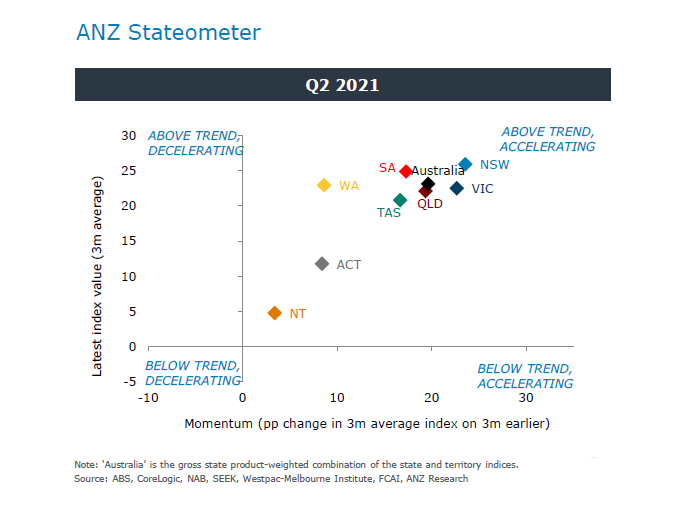-
Economic growth held strong across Australia’s states and territories in the three months to June, the ANZ Stateometer Index found, ahead of the wave of lockdowns seen early in the third quarter.
This strong position and robust momentum is likely help mitigate the direct and indirect impacts of the economic shock to be seen in the next edition.
The pace of growth in all states and territories accelerated above trend in the second quarter of calendar 2021, the ANZ Stateometer showed.
As the Stateometer is based on an annual comparison of indicators, the sharp downturn in the second quarter 2020 means the base effects are very strong for the corresponding period in 2021.
{video}
Broad-based strength was seen across the board in the labour market and consumption also accelerated. Housing broadly consolidated and trade expanded.
New South Wales and Victoria outperformed other regions, partly due to their greater weakness in the second quarter of 2020. The territories lagged, which is in large part a reflection of their resilience during the national lockdown.
Retail consumption was strong, although the third quarter has started off on shaky ground, as many parts of Australia came under varying degrees of lockdown.
Mobility in Sydney and Melbourne was down, according to the Stateometer, close to the record lows of 2020. But the experience of previous lockdowns shows activity and mobility are fairly quick to normalise once they’re over.

Rapid
The labour market recovered quicker than expected from the weakest point in 2020, with only the ACT seeing higher underutilisation in the second quarter when compared to pre-pandemic.
In locked down NSW, Victoria and the ACT, the momentum should underpin a speedy recovery in the labour market once restrictions ease. And the strength in other states should offset some of the employment losses expected in locked down areas.
Among other regions, economic momentum was strong in Queensland’s economy, while in South Australia, all segments of the index saw sequential improvement.
The Western Australia economy sustained its strong momentum, growth in Tasmania accelerated and remained above trend, and the Northern Territory’s economic performance improved, albeit less quickly than its peers.
The ANZ Stateometer is a set of composite indices that measure economic performance across Australia’s states and territories.
For each jurisdiction, the index extracts the common trend across multiple indicators (between 24 and 32, depending on data available in the jurisdiction). The economic indicators are monthly data series and cover the consumer, business, housing, labour and trade sectors.
Developments across this diverse country are rarely uniform and we hope these geographically specific indices help you to see through the haze of state by state data and more intuitively piece together the state of the national economy.
Bansi Madhavani, Catherine Birch & Adelaide Timbrell are Senior Economists, and Arindam Chakraborty is a Junior Economist at ANZ
This is an edited version of an ANZ Research report. You can find the original report HERE.
Related articles
-
Inflation pressures are building, and higher interest rates are likely by 2023 - whether borders are open or not.
-
Further lockdown extensions continue to hurt spending across NSW, particularly in greater Sydney, as the state battles its latest COVID-19 outbreak.
2021-08-20 00:00 -
Despite largely avoiding extended lockdowns, retail in inner-city Adelaide has declined in 2021 compared to pre-pandemic times – and it’s a trend which may continue.
2021-08-24 00:00
This publication is published by Australia and New Zealand Banking Group Limited ABN 11 005 357 522 (“ANZBGL”) in Australia. This publication is intended as thought-leadership material. It is not published with the intention of providing any direct or indirect recommendations relating to any financial product, asset class or trading strategy. The information in this publication is not intended to influence any person to make a decision in relation to a financial product or class of financial products. It is general in nature and does not take account of the circumstances of any individual or class of individuals. Nothing in this publication constitutes a recommendation, solicitation or offer by ANZBGL or its branches or subsidiaries (collectively “ANZ”) to you to acquire a product or service, or an offer by ANZ to provide you with other products or services. All information contained in this publication is based on information available at the time of publication. While this publication has been prepared in good faith, no representation, warranty, assurance or undertaking is or will be made, and no responsibility or liability is or will be accepted by ANZ in relation to the accuracy or completeness of this publication or the use of information contained in this publication. ANZ does not provide any financial, investment, legal or taxation advice in connection with this publication.